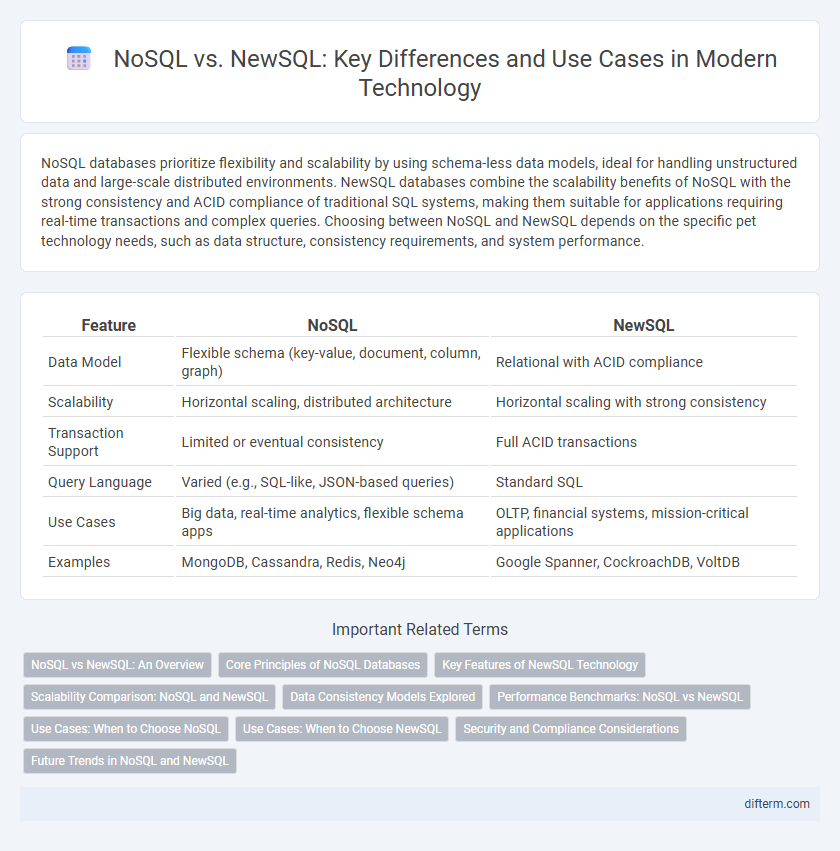NoSQL databases prioritize flexibility and scalability by using schema-less data models, ideal for handling unstructured data and large-scale distributed environments. NewSQL databases combine the scalability benefits of NoSQL with the strong consistency and ACID compliance of traditional SQL systems, making them suitable for applications requiring real-time transactions and complex queries. Choosing between NoSQL and NewSQL depends on the specific pet technology needs, such as data structure, consistency requirements, and system performance.
Table of Comparison
| Feature | NoSQL | NewSQL |
|---|---|---|
| Data Model | Flexible schema (key-value, document, column, graph) | Relational with ACID compliance |
| Scalability | Horizontal scaling, distributed architecture | Horizontal scaling with strong consistency |
| Transaction Support | Limited or eventual consistency | Full ACID transactions |
| Query Language | Varied (e.g., SQL-like, JSON-based queries) | Standard SQL |
| Use Cases | Big data, real-time analytics, flexible schema apps | OLTP, financial systems, mission-critical applications |
| Examples | MongoDB, Cassandra, Redis, Neo4j | Google Spanner, CockroachDB, VoltDB |
NoSQL vs NewSQL: An Overview
NoSQL databases offer flexible schema design, high scalability, and are optimized for unstructured data, making them ideal for big data and real-time web applications. NewSQL databases combine the scalable architecture of NoSQL with the ACID compliance and strict consistency of traditional SQL systems, supporting complex transactions and relational data models. Choosing between NoSQL and NewSQL depends on specific use case requirements like consistency, scalability, and workload complexity.
Core Principles of NoSQL Databases
NoSQL databases prioritize flexible schema design, horizontal scalability, and high availability by distributing data across multiple nodes, enabling efficient handling of unstructured or semi-structured data. They leverage BASE (Basically Available, Soft state, Eventual consistency) principles to ensure system resilience and performance under heavy loads. Key NoSQL types include document stores, key-value stores, column-family stores, and graph databases, each optimized for specific data models and use cases.
Key Features of NewSQL Technology
NewSQL technology combines the scalability of NoSQL databases with the ACID compliance and strong consistency of traditional SQL databases, enabling efficient handling of high transactional workloads. Key features include support for distributed architectures, high availability through replication and failover mechanisms, and optimized in-memory processing for low-latency data access. Advanced indexing and real-time analytics capabilities make NewSQL ideal for applications requiring both high performance and strict data integrity.
Scalability Comparison: NoSQL and NewSQL
NoSQL databases excel in horizontal scalability by distributing data across multiple servers, making them ideal for handling large volumes of unstructured data in real-time applications. NewSQL databases offer scalability similar to NoSQL while maintaining ACID compliance and SQL capabilities, enabling high transaction throughput in OLTP systems. The choice between NoSQL and NewSQL depends on the specific scalability requirements, data consistency needs, and workload characteristics of the application.
Data Consistency Models Explored
NoSQL databases typically embrace eventual consistency models to maximize scalability and availability across distributed systems, allowing temporary data discrepancies. NewSQL databases aim to combine the scalability of NoSQL with the strong ACID compliance of traditional SQL systems, ensuring strict data consistency and transactional integrity. Understanding the trade-offs between eventual consistency in NoSQL and immediate consistency in NewSQL is essential for selecting the right database architecture based on application requirements.
Performance Benchmarks: NoSQL vs NewSQL
Performance benchmarks reveal that NewSQL databases typically outperform NoSQL systems in transactional consistency and latency under high concurrency workloads, leveraging ACID compliance with scalable architectures. NoSQL databases excel in horizontal scaling and flexibility for unstructured data but may experience trade-offs in strict consistency and complex query performance. Evaluations based on throughput, response time, and fault tolerance demonstrate NewSQL's advantage in mission-critical applications requiring strong consistency and real-time analytics.
Use Cases: When to Choose NoSQL
NoSQL databases excel in handling large volumes of unstructured or semi-structured data, making them ideal for real-time analytics, content management, and IoT applications. They provide high scalability and flexibility, supporting distributed architectures for horizontal scaling across multiple servers. NoSQL is often chosen for projects requiring rapid development, schema-less designs, and high availability in cloud-native environments.
Use Cases: When to Choose NewSQL
NewSQL databases excel in handling complex transactions at high speed, making them ideal for financial services and real-time analytics where consistency and scalability are critical. They support ACID compliance while maintaining the horizontal scalability of NoSQL, providing a robust solution for e-commerce platforms and mobile applications requiring high concurrency. Organizations prioritizing strong transactional guarantees without sacrificing performance should choose NewSQL over NoSQL for their mission-critical workloads.
Security and Compliance Considerations
NoSQL databases, while offering flexible schema designs and high scalability, often pose challenges in enforcing strict security protocols and compliance standards due to their eventual consistency models and lack of robust transaction support. NewSQL databases combine the scalability of NoSQL with the strong ACID compliance and security features typical of traditional SQL systems, making them more suitable for industries with stringent regulatory requirements such as finance and healthcare. Organizations prioritizing data integrity, real-time security auditing, and compliance with standards like GDPR or HIPAA generally benefit more from NewSQL solutions than from NoSQL alternatives.
Future Trends in NoSQL and NewSQL
NoSQL databases continue to evolve with enhanced scalability, real-time processing, and better support for unstructured data, making them ideal for big data and IoT applications. NewSQL systems integrate traditional relational database features with modern scalability, offering strong consistency and high transaction throughput for cloud-native environments. Future trends emphasize hybrid architectures combining NoSQL flexibility with NewSQL's ACID compliance to meet complex enterprise demands.
NoSQL vs NewSQL Infographic

 difterm.com
difterm.com